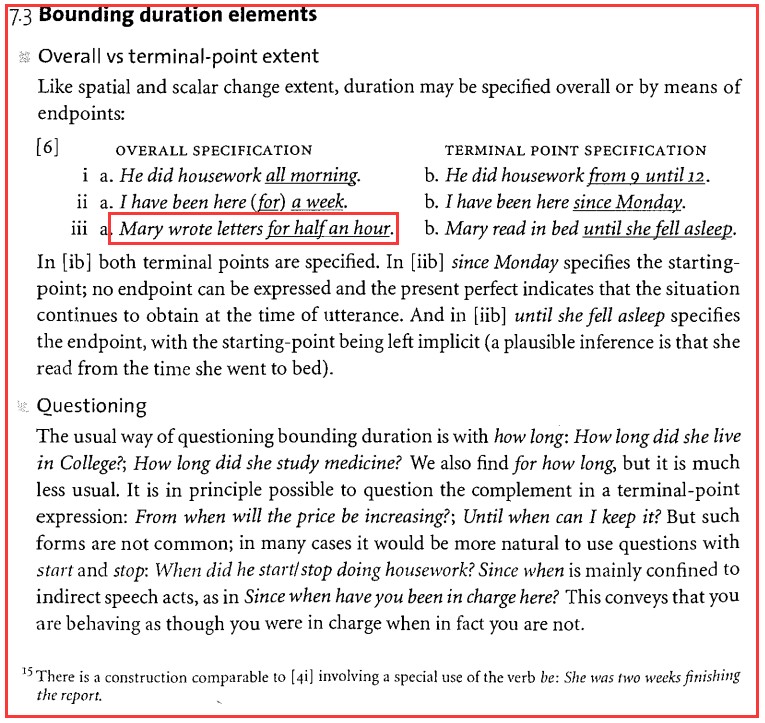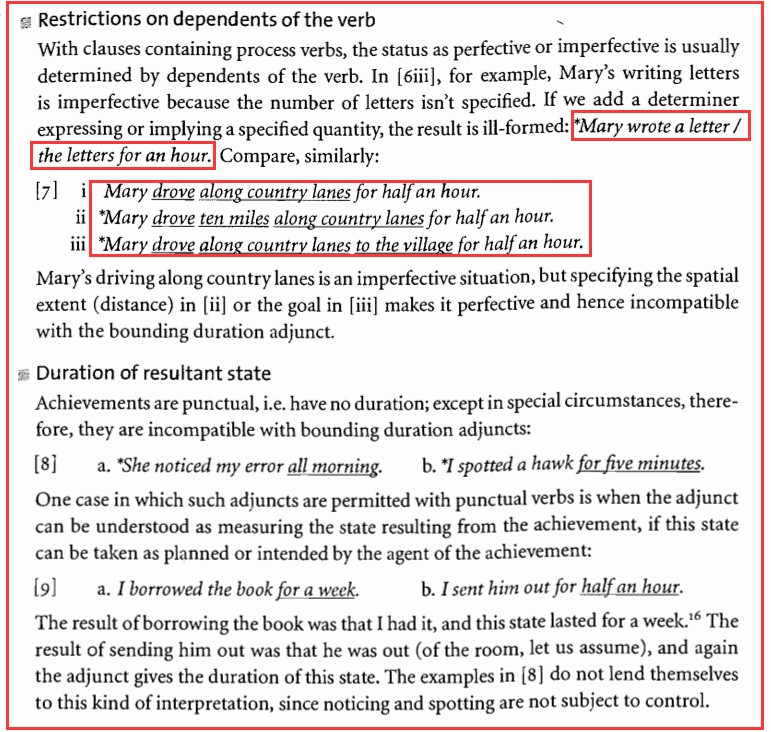5 Mary wrote a letter / the letters for an hour.错在哪(请教曹老师)
记得在咱们的柯帕斯英语网上的有个地方(但找不到具体的网址了)听曹老师说过Mary wrote a
letter / the letters for an hour是错误的。碰巧今天无意中在剑桥英语语法上看到这个原句,但全版的英文对我来说太难了,看不懂,所以特地请教一下曹老师,为什么下面第一句是对的,而第二句却是错误的?
正:Mary wrote letters for half an hour.
误:Mary wrote a letter / the letters for an hour.
还有该书在同一个地方还列出了以下句子(我也不明白为什么第一句对,而后面两句错):
正:Mary drove along country lanes for half an hour.
误:Mary drove ten miles along country lanes for half an hour.
误:Mary drove along country lanes to the village for half an hour.
知道曹老师对剑桥语法很有研究,想麻烦曹老师指点一下,万分感谢!


最佳答案 2021-10-12 20:24
终结性动词的非进行体表示动作的结束,状态发生改变。例如,Mary wrote the letters/a letter.这句话告诉我们,玛丽写完了信。信从无到有,结果状态产生。而for时间状语表示的是动作的实际持续时间,与终结动词的结束意义不相容,所以不可以与表示终结意义的动词形式连用。这就是为什么 Mary wrote the letters/a letter后接for持续状语为错误的道理。但如果wrote的宾语为letters,没有限定词,则wrote letters 并没有结束意义,所以可以和for时间状语连用,表示动作的持续时间。如果想要表示终结性动词的动作持续多久后结束产生结果,要用in介词短语表示,而不用for时间状语。例如,Mary wrote the letters/a letter in half an hour.
非终结动词通常需要借助状语表示动词结束的意义。所以剑桥英语语法把赋予非终结动词以结束意义的短语称为bounding duration elements. 例如,Mary drove along country lanes. 这个谓语动词表示的是非终结动作。我们读这个句子的时候,我们脑子里的画面是玛丽在乡村小路上开着车,动作没有结束。我们给这个句子加上for时间状语,Mary drove along country lanes for half an hour. for时间状语表示动作实际持续时间,即从开始到结束,开车的时间为半个小时。for时间状语赋予这个句子以结束意义。Mary drove ten miles along the country lanes. Mary drove along the country lanes to the village. 这二个句子中,ten miles 和 to the village 都是赋予这个句子以结束意义,表示开车开了10英里后结束了,开到村庄后结束了。此时句子就不可以用for时间状语连用。如果想要表示用了多长时间开了10英里或开到村庄,则需要in 介词短语,in half an hour. 不能用for时间状语。
这就是剑桥语法这段话的意思。
如果觉得我的回答对您有用,请随意打赏。你的支持将鼓励我继续创作!

- 2 关注
- 4 收藏,2455 浏览
- 江晓敏 提出于 2021-10-11 00:33
相似问题
- 介词在句首不能省略吗 1 回答
- for的理解 1 回答
- 请问这里为什么用for来搭配进行时 1 回答
- for如何理解(It's for a full-time fitness instructor)-来自剑桥英语教材 2 回答
- 剑桥英语语法屈折词形标准 1 回答
- in most people 还是 for most people 1 回答
-
 《高考英语备考1号·速效编》
《高考英语备考1号·速效编》
-
 《高考英语备考1号·写作编》
《高考英语备考1号·写作编》
-
 《高中英语晨读晚记》
《高中英语晨读晚记》
-
 《高中英语错题笔记》
《高中英语错题笔记》
-
 《零起点考大学英语》
《零起点考大学英语》
-
